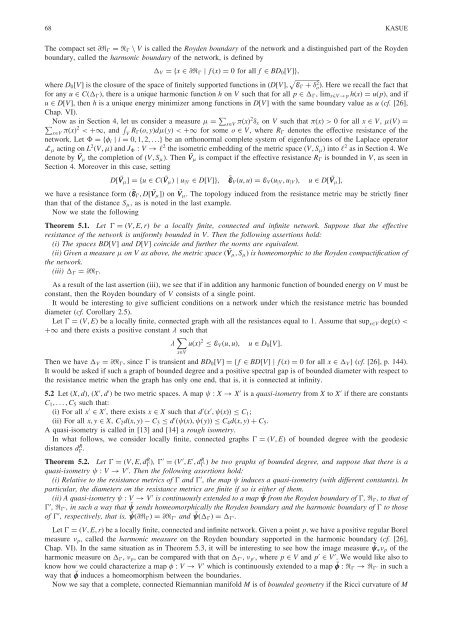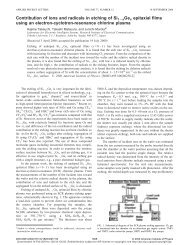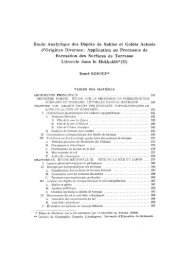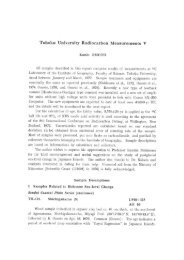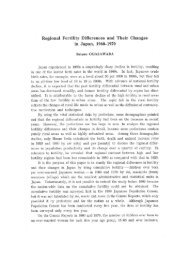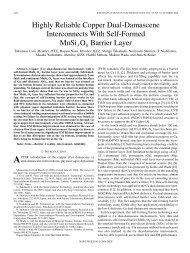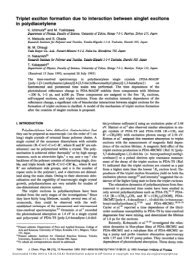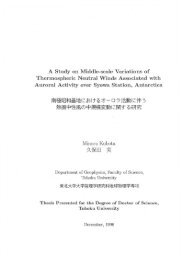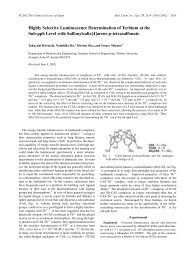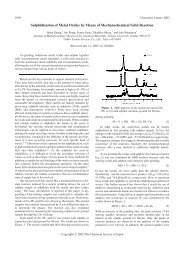Variational Convergence of Finite Networks
Variational Convergence of Finite Networks
Variational Convergence of Finite Networks
Create successful ePaper yourself
Turn your PDF publications into a flip-book with our unique Google optimized e-Paper software.
68 KASUE<br />
The compact set @< ¼< n V is called the Royden boundary <strong>of</strong> the network and a distinguished part <strong>of</strong> the Royden<br />
boundary, called the harmonic boundary <strong>of</strong> the network, is defined by<br />
V ¼fx 2 @< j f ðxÞ ¼0 for all f 2 BD0½VŠg;<br />
ffiffiffiffiffiffiffiffiffiffiffiffiffiffiffi<br />
where D0½VŠ is the closure <strong>of</strong> the space <strong>of</strong> finitely supported functions in ðD½VŠ; E þ 2 p<br />
oÞ.<br />
Here we recall the fact that<br />
for any u 2 Cð Þ, there is a unique harmonic function h on V such that for all p 2 , limx2V!p hðxÞ ¼uðpÞ, and if<br />
u 2 D½VŠ, then h is a unique energy minimizer among functions in D½VŠ with the same boundary value as u (cf. [26],<br />
Chap. VI).<br />
Now as in Section 4, let us consider a measure ¼ P<br />
x2V ðxÞ2 P<br />
x on V such that ðxÞ > 0 for all x 2 V, ðVÞ ¼<br />
x2V ðxÞ2 < þ1, and R<br />
V R ðo; yÞd ðyÞ < þ1 for some o 2 V, where R denotes the effective resistance <strong>of</strong> the<br />
network. Let ¼f i j i ¼ 0; 1; 2; ...g be an orthonormal complete system <strong>of</strong> eigenfunctions <strong>of</strong> the Laplace operator<br />
L acting on L2ðV; Þ and J : V ! ‘ 2 the isometric embedding <strong>of</strong> the metric space ðV; S Þ into ‘ 2 as in Section 4. We<br />
denote by V the completion <strong>of</strong> ðV; S Þ. ThenVis compact if the effective resistance R is bounded in V, as seen in<br />
Section 4. Moreover in this case, setting<br />
D½V Š¼fu 2 CðV ÞjujV 2 D½VŠg; EVðu; uÞ ¼EVðujV; ujVÞ; u 2 D½V Š;<br />
we have a resistance form ðE ; D½V ŠÞ on V . The topology induced from the resistance metric may be strictly finer<br />
than that <strong>of</strong> the distance S , as is noted in the last example.<br />
Now we state the following<br />
Theorem 5.1. Let ¼ðV; E; rÞ be a locally finite, connected and infinite network. Suppose that the effective<br />
resistance <strong>of</strong> the network is uniformly bounded in V. Then the following assertions hold:<br />
(i) The spaces BD½VŠ and D½VŠ coincide and further the norms are equivalent.<br />
(ii) Given a measure on V as above, the metric space ðV ; S Þ is homeomorphic to the Royden compactification <strong>of</strong><br />
the network.<br />
(iii) ¼ @< .<br />
As a result <strong>of</strong> the last assertion (iii), we see that if in addition any harmonic function <strong>of</strong> bounded energy on V must be<br />
constant, then the Royden boundary <strong>of</strong> V consists <strong>of</strong> a single point.<br />
It would be interesting to give sufficient conditions on a network under which the resistance metric has bounded<br />
diameter (cf. Corollary 2.5).<br />
Let ¼ðV; EÞ be a locally finite, connected graph with all the resistances equal to 1. Assume that supx2V degðxÞ <<br />
þ1 and there exists a positive constant such that<br />
X<br />
uðxÞ 2<br />
EVðu; uÞ; u 2 D0½VŠ:<br />
x2V<br />
Then we have V ¼ @< , since is transient and BD0½VŠ ¼ff 2 BD½VŠ j f ðxÞ ¼0 for all x 2 Vg (cf. [26], p. 144).<br />
It would be asked if such a graph <strong>of</strong> bounded degree and a positive spectral gap is <strong>of</strong> bounded diameter with respect to<br />
the resistance metric when the graph has only one end, that is, it is connected at infinity.<br />
5.2 Let ðX; dÞ, ðX0 ; d0Þ be two metric spaces. A map : X ! X0 is a quasi-isometry from X to X0 if there are constants<br />
C1; ...; C5 such that:<br />
(i) For all x0 2 X0 , there exists x 2 X such that d0ðx0 ; ðxÞÞ C1;<br />
(ii) For all x; y 2 X, C2dðx; yÞ C3 d0ð ðxÞ; ðyÞÞ C4dðx; yÞþC5.<br />
A quasi-isometry is called in [13] and [14] a rough isometry.<br />
In what follows, we consider locally finite, connected graphs<br />
distances d<br />
¼ðV; EÞ <strong>of</strong> bounded degree with the geodesic<br />
R .<br />
Theorem 5.2. Let ¼ðV; E; dRÞ, 0 0 0 R ¼ðV ; E ; d 0Þ be two graphs <strong>of</strong> bounded degree, and suppose that there is a<br />
quasi-isometry : V ! V0 . Then the following assertions hold:<br />
(i) Relative to the resistance metrics <strong>of</strong> and 0 , the map induces a quasi-isometry (with different constants). In<br />
particular, the diameters on the resistance metrics are finite if so is either <strong>of</strong> them.<br />
(ii) A quasi-isometry : V ! V0 is continuously extended to a map from the Royden boundary <strong>of</strong> , < , to that <strong>of</strong><br />
0 , < 0, in such a way that sends homeomorphically the Royden boundary and the harmonic boundary <strong>of</strong> to those<br />
<strong>of</strong> 0 , respectively, that is, ð@< Þ¼@< 0 and ð Þ¼ 0.<br />
Let ¼ðV; E; rÞ be a locally finite, connected and infinite network. Given a point p, we have a positive regular Borel<br />
measure p, called the harmonic measure on the Royden boundary supported in the harmonic boundary (cf. [26],<br />
Chap. VI). In the same situation as in Theorem 5.3, it will be interesting to see how the image measure p <strong>of</strong> the<br />
harmonic measure on , p, can be compared with that on 0, p0, where p 2 V and p0 2 V0 . We would like also to<br />
know how we could characterize a map : V ! V0 which is continuously extended to a map : < !< 0 in such a<br />
way that induces a homeomorphism between the boundaries.<br />
Now we say that a complete, connected Riemannian manifold M is <strong>of</strong> bounded geometry if the Ricci curvature <strong>of</strong> M


